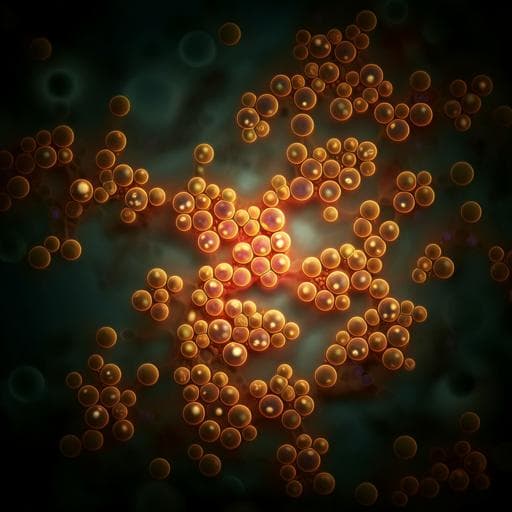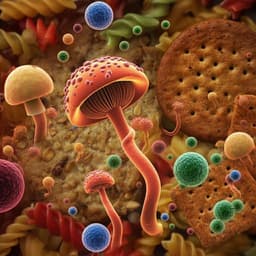
Food Science and Technology
Unraveling the fate of mycotoxins during the production of legume protein and other derived products
M. A. Pavicich, L. Roose, et al.
Dive into the intriguing world of mycotoxins in legume-derived products explored by María Agustina Pavicich and colleagues. This research reveals how various processing steps can affect mycotoxin levels, emphasizing the importance of mitigation techniques to ensure product safety.
~3 min • Beginner • English
Introduction
The study addresses how mycotoxins behave during industrial processing of legumes into protein and other derived products. With growing adoption of plant-based diets, legumes are central for protein and fiber intake but are susceptible to fungal contamination by Aspergillus, Fusarium, Penicillium and Alternaria species that produce toxic mycotoxins. Climate change and improved analytics have increased observed mycotoxin prevalence, with higher burdens in developing regions. Mycotoxins are relatively stable and can persist through processing, potentially redistributing, concentrating, degrading, or modifying chemically. The purpose of this work is to track fluctuations in multiple mycotoxins throughout processing, from raw materials to intermediate, final products and side streams, to assess contributions to contamination in commercial legume-derived products and identify processing steps that mitigate or exacerbate risks.
Literature Review
Background literature shows numerous processing operations (cleaning, milling, cooking, baking, roasting, extrusion, alkaline cooking/nixtamalization, extraction) can reduce but rarely eliminate mycotoxins, and may release bound toxins or form modified products with altered toxicokinetics. Major mycotoxin producers include Aspergillus, Fusarium, Penicillium and Alternaria, with prevalence influenced by climate conditions and postharvest practices. Many mycotoxins exhibit heat stability, with significant reductions typically at higher temperatures (>150 °C for fumonisins). While cereal processing has been extensively studied, there is limited information on legume processing. This study fills a gap by examining multiple mycotoxins across a full legume processing line, considering potential concentration in fractions and side streams (e.g., dust, wash water) and effects of alkaline solubilization and thermal treatments.
Methodology
Study design and samples: Forty-one 1-kg legume samples from two production batches (different dates and suppliers) were collected along an industrial processing line under non-disclosure of legume species and company. Sampling covered raw materials, intermediate fractions (e.g., hulls, hydrated milled legume, liquid fraction after decantation, concentrates, solid fractions destined for products C and D, large and fine sieved fractions), final products (A–D), and side streams (dust, washing water, solubles). Raw materials were naturally low-contaminated; thus, a mass balance could not be established.
Quantification approach: Matrix-matched calibration curves (MMCC) were prepared on blank legume flour (five blanks spiked with multi-mycotoxin mix). Identification followed SANTE/12089/2016 criteria; results below LOD/LOQ but meeting identification criteria were reported as detected without a numeric concentration.
Sample preparation: Homogenized/milled samples (5 g) were spiked with internal standards zearalanone (ZAN, 250 µg/kg) and deepoxy-deoxynivalenol (DOM, 150 µg/kg) for most analytes and DON-related compounds, respectively. Extraction used 20 mL ACN/H2O/acetic acid (79/20/1, v/v/v), with vortexing, agitation, centrifugation (4000×g, 15 min), and C18 SPE cleanup. A second 5 mL extraction was combined to 25 mL with extraction solvent. Defatting used 10 mL hexane. The extract was split: one part filtered; the other mixed with ACN/acetic acid (99/1) and passed through a MultiSep 226 AflaZon+ multifunctional column. The Multisep eluate was combined with the filtered portion, evaporated under N2 at 40 °C, and reconstituted in injection solvent (mixture of mobile phases A and B at 3:2 v/v). Final centrifugation (14,000 g, 10 min) and PVDF filtration preceded LC-MS/MS.
LC-MS/MS conditions: Waters Acquity HPLC coupled to Micromass Quattro Premier XE triple quadrupole. Column: Symmetry C18, 150 × 2.1 mm, 5 µm, with guard column. Flow: 0.3 mL/min; gradient over 28 min using mobile phase A (H2O/MeOH/acetic acid 94/5/1 + 5 mM ammonium acetate) and B (H2O/MeOH/acetic acid 2/97/1 + 5 mM ammonium acetate). Injection: 10 µL. ESI+ SRM mode; source/desolvation temps 150/350 °C; capillary 3.2 kV; N2 desolvation gas. Transitions, cone voltages, collision energies optimized per analyte (details in cited references and Supplementary Materials). Method performance (LOD/LOQ, apparent recovery, RSDr, RSD) provided in Supplementary Materials. Calibration and quantitation used MassLynx/QuanLynx software.
Analytes and standards: Panel included OTA, aflatoxins (B1, B2, G1, G2), DON, ZEN, fumonisins (FB1, FB2, FB3), NIV, NEO, DOM, T2, HT2, 3-ADON, 15-ADON, DAS, FX, STC, ROQ-C, AME, AOH, ENN B, among others. Solvents were HPLC/MS-grade.
Key Findings
- Raw materials: All targeted mycotoxins were below LOD in both raw materials; mass balance could not be established.
- Intermediate products (Table 1):
• Hull 1: AME detected (below LOD/LOQ); Hull 2: none detected.
• Hydrated milled legume 1: DON, T2, and STC detected (below LOD/LOQ); replicate 2: none detected.
• Liquid fraction after decantation 1: T2 and ENN B detected (below LOD/LOQ); replicate 2: none detected.
• Concentrate 1: NIV, FB1, STC, and ENN B detected (below LOD/LOQ); replicate 2: none detected.
• Solid fraction for C+D 2: T2, STC, and ENN B detected (below LOD/LOQ); replicate 1: none detected.
• Large and fine sieved fractions (both replicates): none detected.
- Final products (Table 2): AME detected (below LOD/LOQ) in Product B (one of two replicates). Products A, C, and D: none detected for AME; no other mycotoxins detected in final products.
- Side streams (Table 3):
• Dust: AME quantified at 39 and 46 µg/kg in two dust samples; DON detected (below LOD/LOQ) in both; STC detected (below LOD/LOQ) in one.
• Washing water 2: ENN B detected (below LOD/LOQ); washing water 1: none detected.
• Solubles: Soluble C 2: ENN B detected (below LOD/LOQ); other soluble samples (B1–2, C1, D1–2): none detected.
- Flowchart/narrative synthesis: Milling and alkaline solubilization steps were associated with detection of ENN B in intermediate and side-stream fractions; concentration steps coincided with detectable FB1 in a concentrate. Overall, only AME was detected in a final product (Product B), while other mycotoxins were absent from final products.
Discussion
The study traced multiple mycotoxins across an industrial legume processing chain, demonstrating how processing can release, redistribute, concentrate, or reduce contaminants. ENN B appeared in certain intermediates and side streams, particularly after milling and alkaline solubilization, consistent with the hypothesis that processing can liberate mycotoxins from matrices and that alkaline conditions facilitate complexation and selective extraction of ENN B to soluble streams. The circulating wash-water loop can also contribute to cross-batch redistribution.
Dust contained concentrated DON and AME (and occasionally STC), indicating particle abrasion/sieving can partition mycotoxins into dust, effectively removing them from food products but highlighting occupational/environmental exposure controls. FB1 was detected after thermal concentration, likely due to solids concentration and the heat stability of fumonisins at temperatures below ~150 °C; subsequent treatments reduced FB1 to undetectable levels in final products.
AME, frequently detected along the process and quantified in dust, was also detected in one final product (B), aligning with literature that Alternaria toxins can resist conventional processing. Conversely, T2 and NIV, though detected in intermediates, were absent from final products, suggesting washing, thermal treatment, and solubilization steps reduced these to below detection. OTA, the only mycotoxin regulated in legumes, was not detected in any step.
These findings address the research question by pinpointing critical control points: sieving/dust removal, thermal treatments, and especially alkaline solubilization substantially influence mycotoxin fate. While overall contamination in legume-derived products appeared lower than typical reports for cereals, persistent toxins like AME warrant monitoring and potential risk management.
Conclusion
This work is, to the authors’ knowledge, the first to systematically track multiple mycotoxins through the industrial production of legume protein and derived products. Key contributions include: (i) demonstrating that milling and alkaline solubilization can release and partition ENN B into side streams; (ii) showing that thermal processing and drying effectively reduce several mycotoxins (e.g., FB1, T2, NIV) to undetectable levels in final products; (iii) identifying dust as a hotspot for AME and DON; and (iv) observing AME persistence with detection in one final product. Practical implications include optimizing dust management, monitoring wash-water loops, and leveraging alkaline solubilization to minimize carryover into food fractions. Future research should analyze more batches across seasons/regions, include targeted studies on AME behavior, and use artificially contaminated or inoculated raw materials to enable mass-balance assessments and clarify transformation pathways.
Limitations
- Only two production batches from undisclosed legume species and processor, limiting generalizability.
- Naturally low-contaminated raw materials prevented establishing a full mass balance.
- Many detections were below LOD/LOQ (identified qualitatively), constraining quantitative interpretation.
- Potential batch-to-batch variability and seasonal/region effects were not captured.
- Side-stream recirculation (e.g., wash water) could introduce cross-batch carryover, complicating attribution.
- The study focused on a subset of mycotoxins detectable by the method; modified/unknown metabolites may be underrepresented.
Related Publications
Explore these studies to deepen your understanding of the subject.







